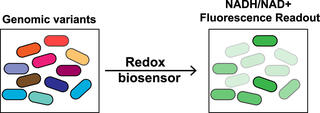New biosensor highlights candidate microbes for biofuel production

The new technology could facilitate the identification of promising biofuel-producing microbes.
The Science
NADH and NAD+ cofactors drive hundreds of biochemical reactions, and their ratio is a key metabolic marker of cellular state. Microbes used for biofuel production require excess NADH to drive biosynthesis of the desired compounds. Because of this requirement, the ratio between NADH and NAD+ is a useful way to identify bacterial strains that are good candidates for biofuel production. Traditional assays to measure the NADH/NAD+ ratio are laborious, prone to inaccuracies, and not suitable for high-throughput screening. New research from the Great Lakes Bioenergy Research Center (GLBRC) unveils a genetically encoded biosensor that triggers green fluorescence in cells with high NADH levels, enabling rapid identification of the strains best primed for biofuel production.
The Impact
The new biosensor technology offers major improvements over previous methods for identifying promising microbial strains for biofuel production, making the process cheaper, faster, and more accurate. NADH is also an important metabolic marker in human health and disease, so the ability to visualize NADH/NAD+ imbalances quickly and easily also has broad potential applications in medicine and biotechnology.
Summary
Cells maintain a balance of NADH and NAD+ during normal growth and respiration. If excess NADH builds up, the cell can divert some of its energy away from routine growth and toward biofuel production. The GLBRC research team designed a biosensor, based on a redox-responsive bacterial transcription factor, that fluoresces in response to high NADH levels. The researchers used this biosensor to investigate the differential effects of removing various respiratory chain enzymes that normally regulate NADH and NAD+ levels in cells. They also used the biosensor to determine NADH/NAD+ ratios in E. coli colonies growing on a variety of common carbon sources, which may reflect metabolic changes or stress responses to growing on different substrates. In addition, the researchers used the biosensor to pinpoint individual cells engineered to have high NADH among a field of 10,000 wild-type cells, demonstrating its utility for high-throughput screening. The findings suggest that the biosensor is a powerful tool for exploring and engineering redox metabolism in a variety of biological contexts.
Program Manager
N. Kent Peters
kent.peters@science.doe.gov, 301-903-5549
Principal Investigator
Vatsan Raman
sraman4@wisc.edu
Funding
This work was supported by U.S. Department of Energy (DOE) Great Lakes Bioenergy Research Center grant (DOE BER Office of Science DE-FC02-07ER6449).
Publications
Y. Liu, R. Landick, and S. Raman, “A Regulatory NADH/NAD+ Redox Biosensor for Bacteria.” ACS Synthetic Biology 8 (2), 264-273 (2019). 10.1021/acssynbio.8b00485
Related Links
https://www.glbrc.org/news/new-biosensor-highlights-best-biofuel-producing-microbes